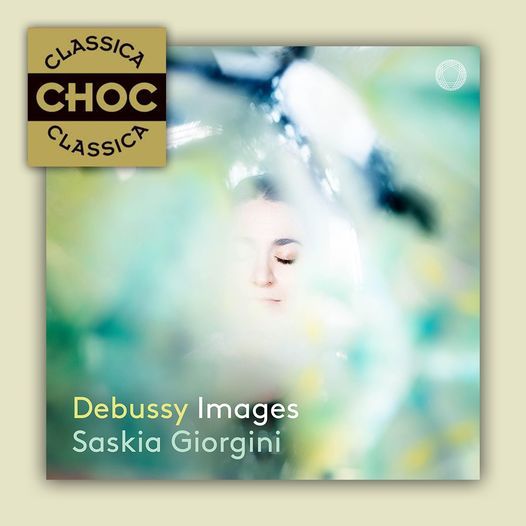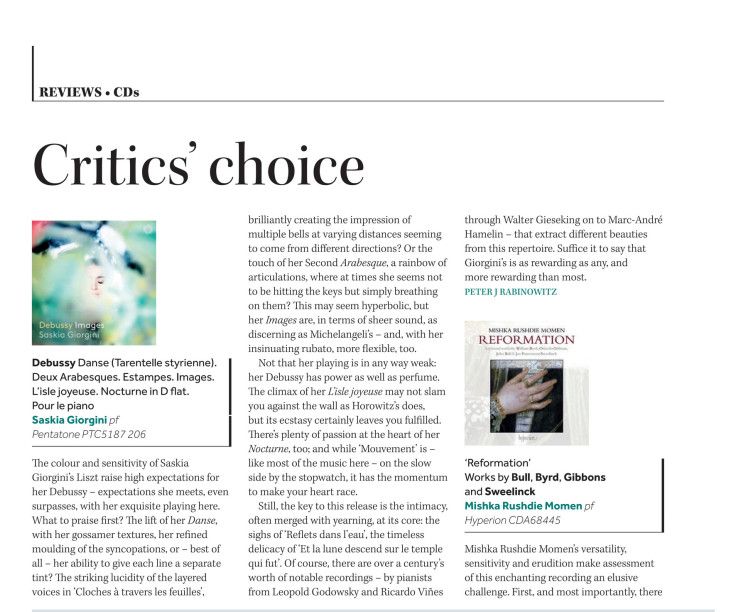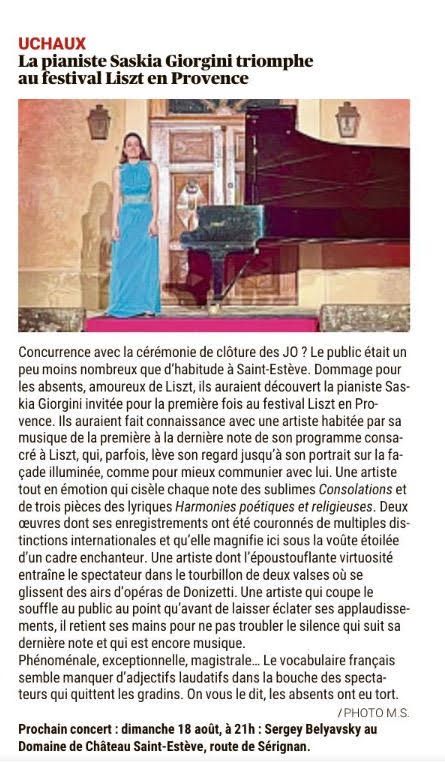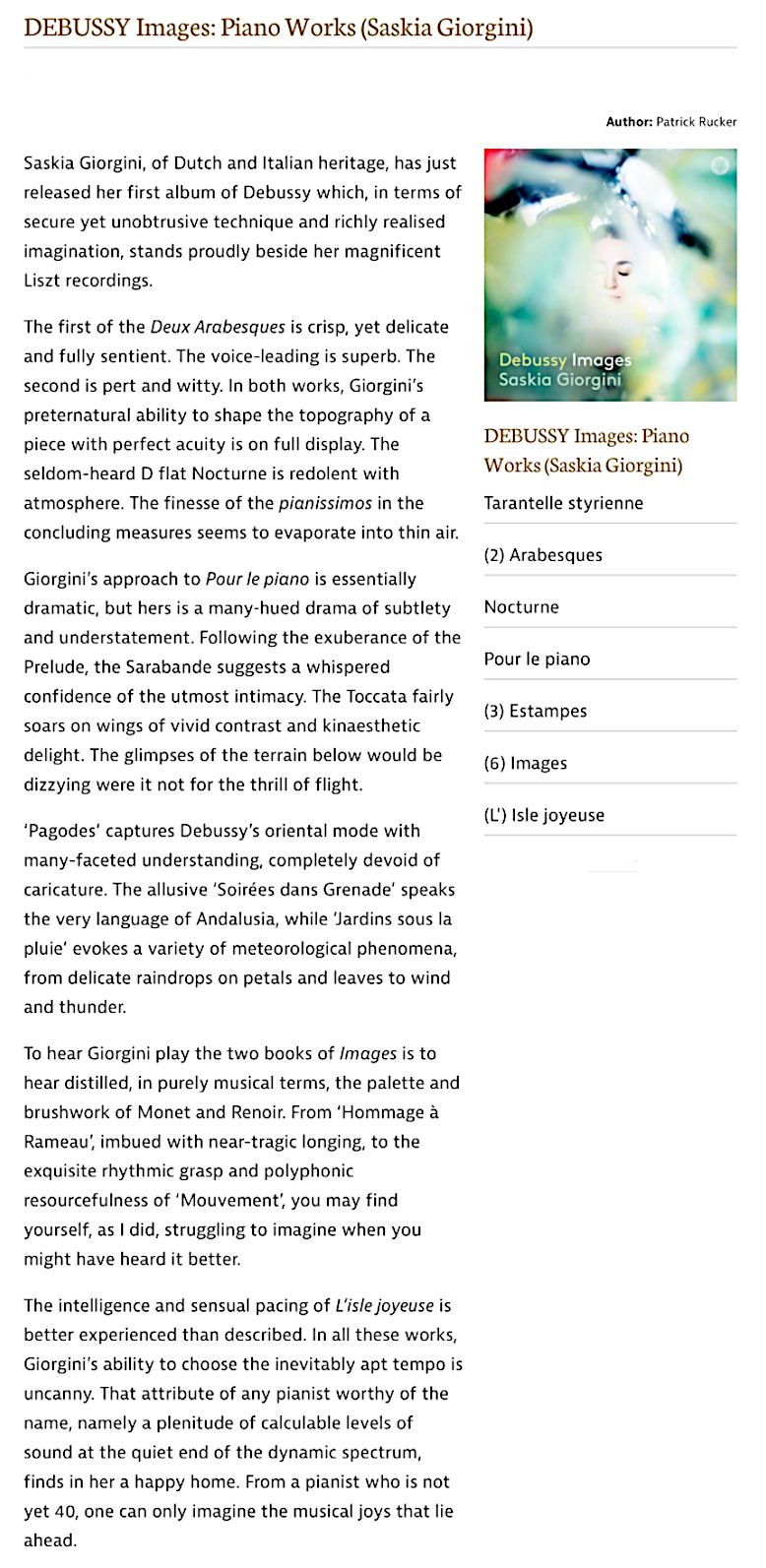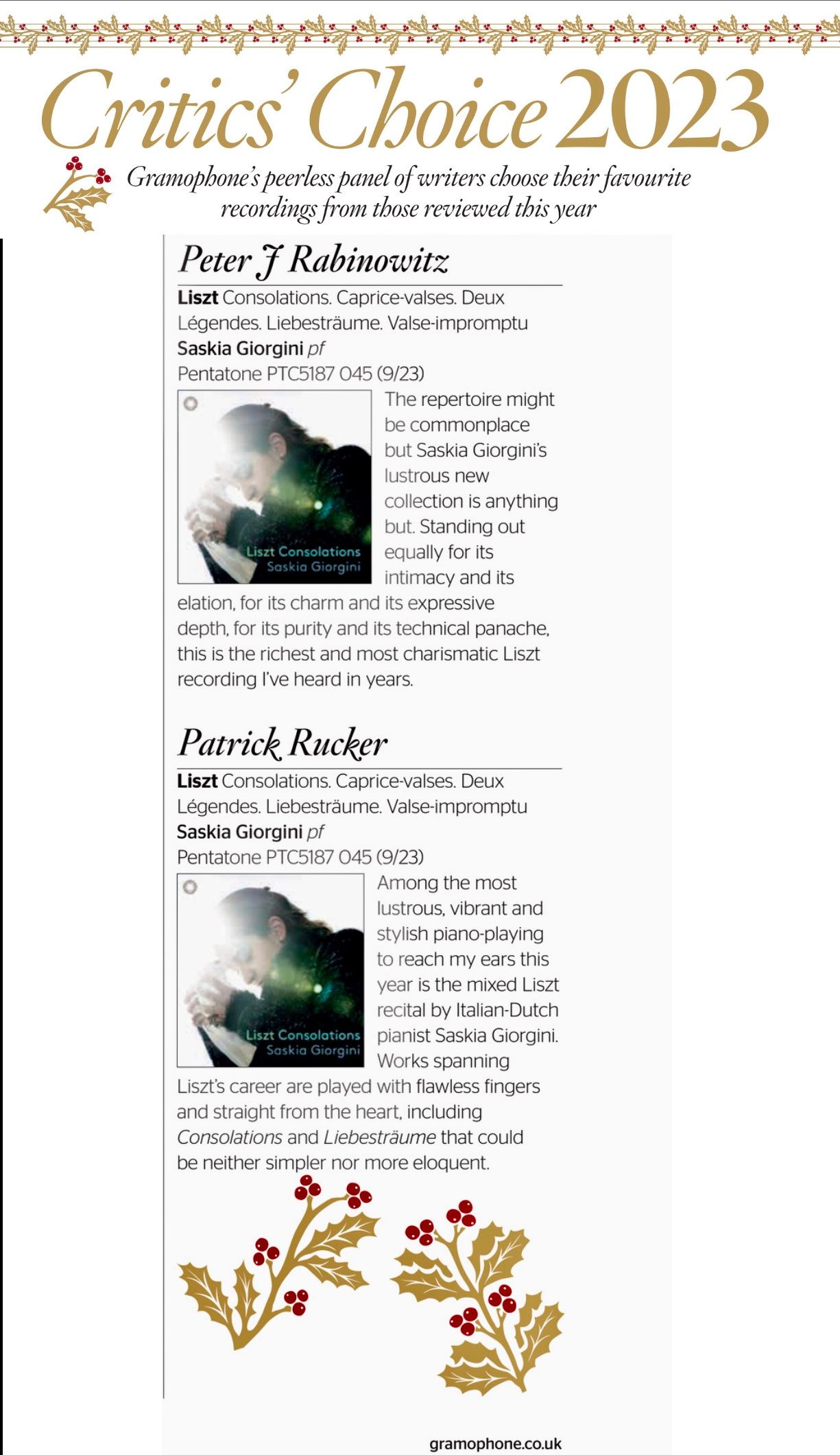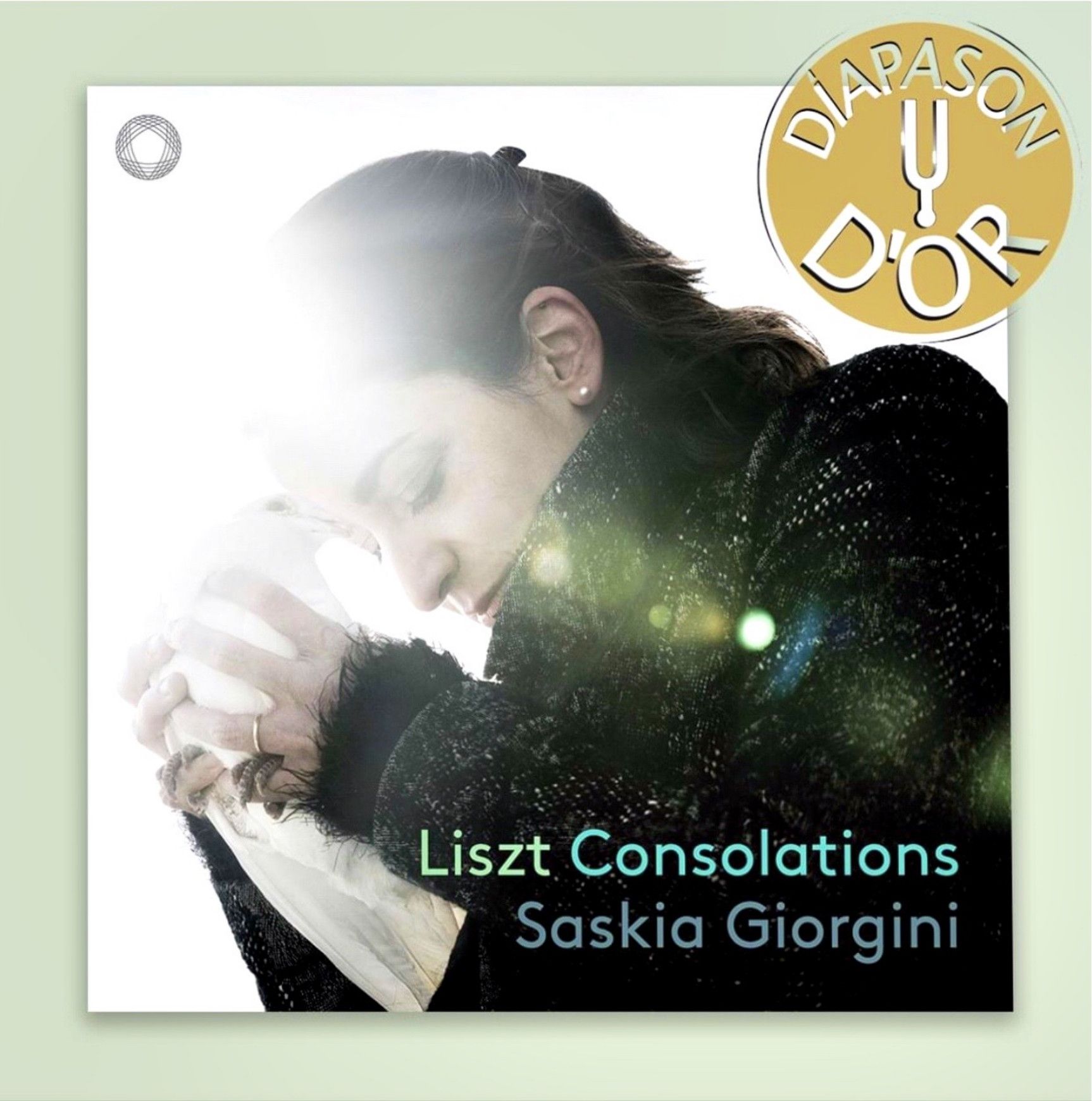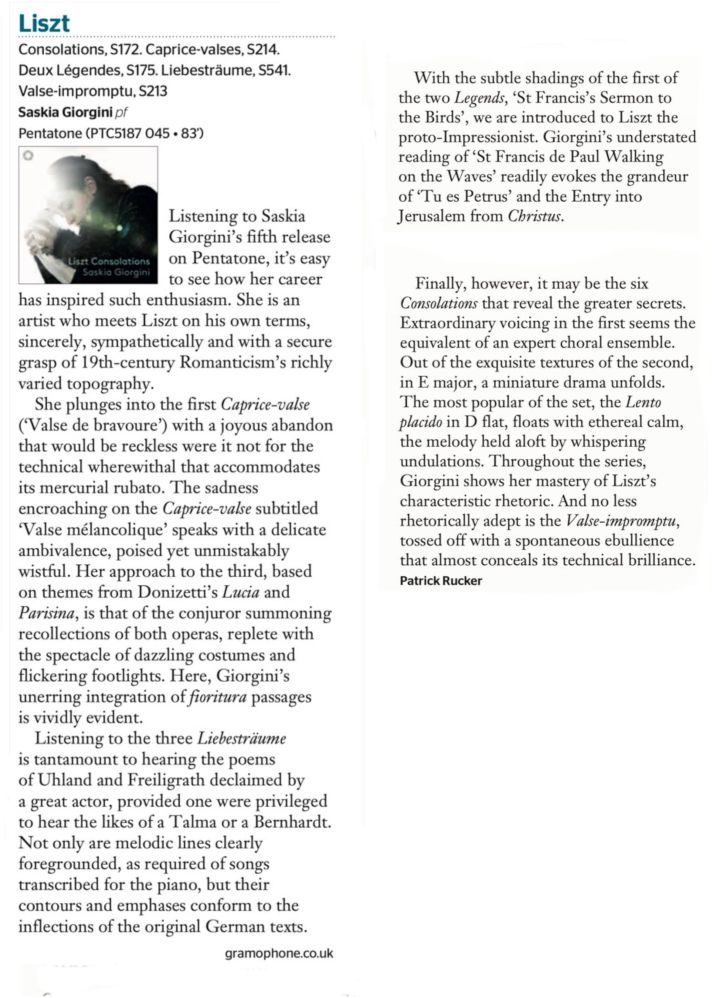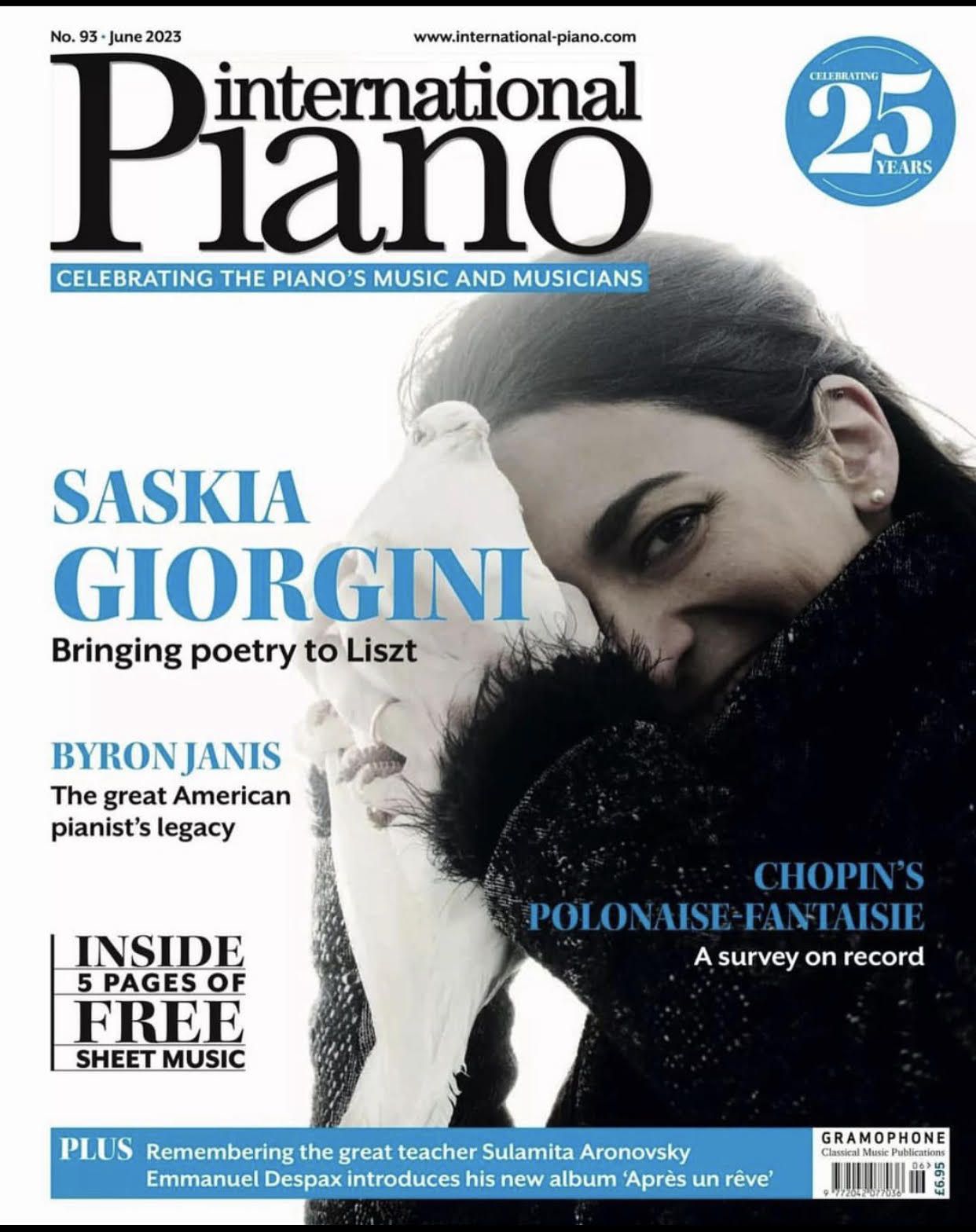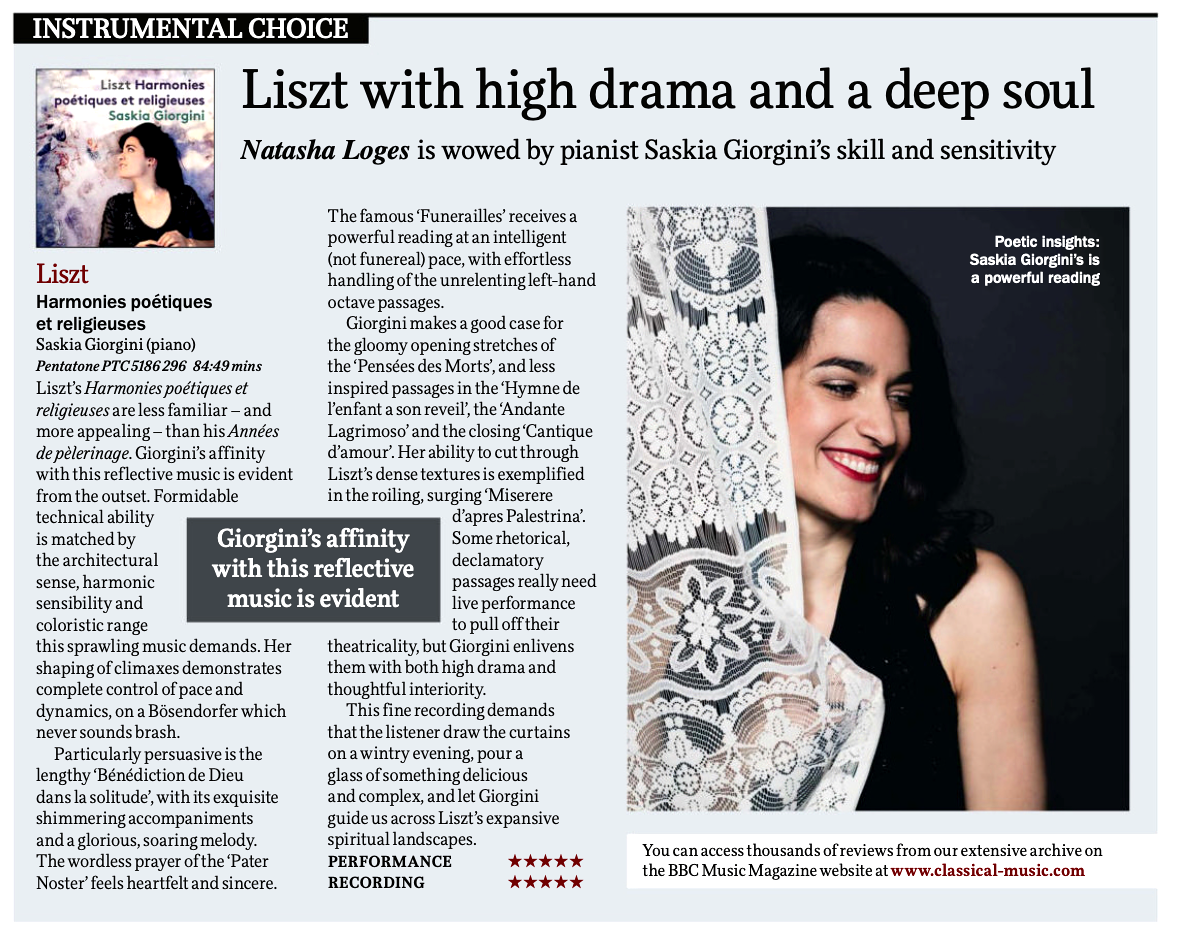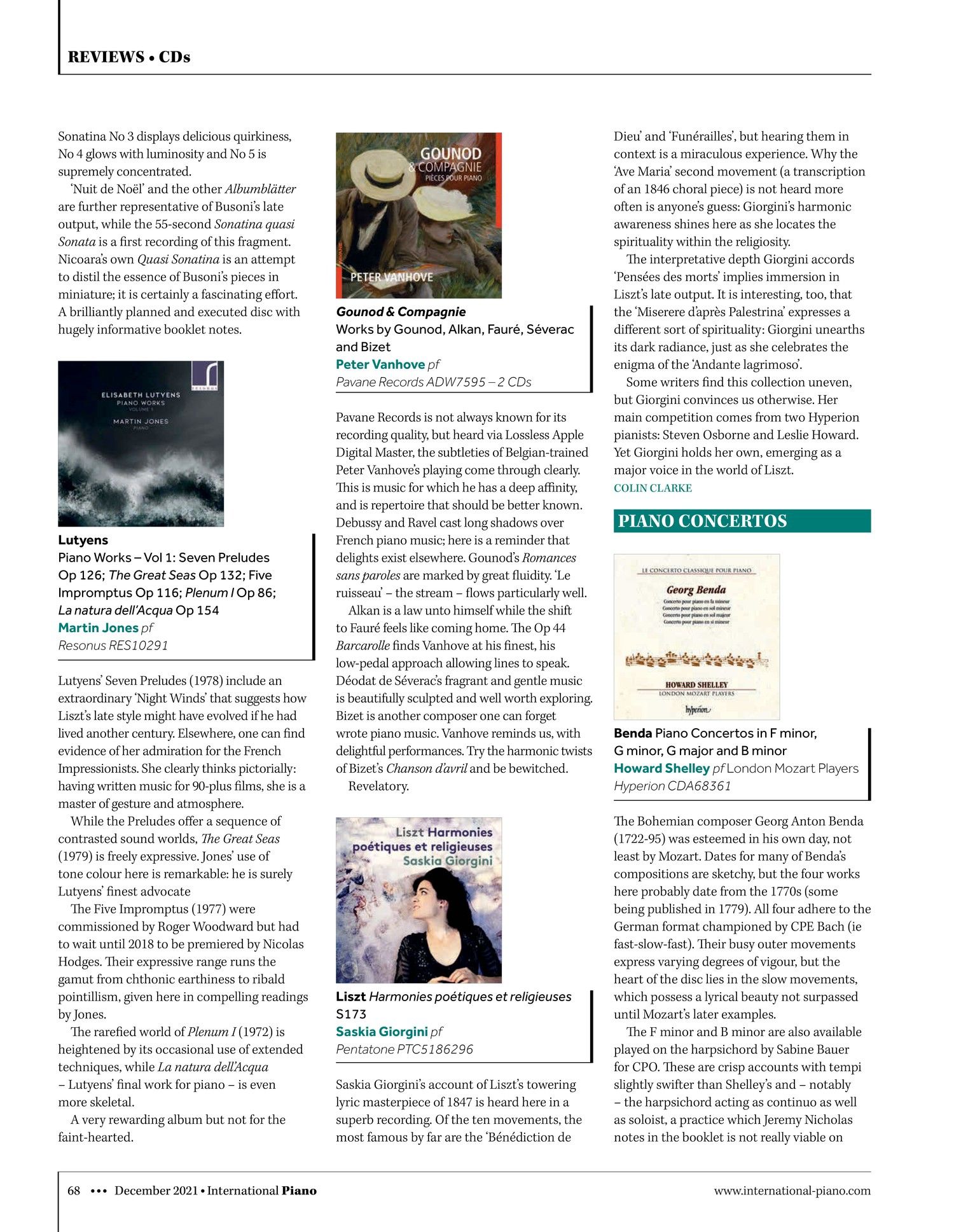Press
Press
Angers Pianopolis Festival 2024
Alexandre Kantorow discovered Saskia Giorgini through her records dedicated to Franz Liszt. The pianist imposes herself with her presence, her personality, from the first Waltz of Frédéric Chopin’s Opus 34. What generosity and clarity of playing, what timbre, what health of sound! This Waltz is remarkable in its pace, its brilliance without clicking, its cheerfulness although crossed by an ephemeral cloud. The second breathes and sings with a sumptuous line. Healthy virtuosity and effervescent fingers give panache to the last one.
There is no need to do more than is necessary in Chopin’s Nocturne op.15 n°3: the pianist understood this well, giving this music only what it requires in terms of depth and sobriety, erasing in the contours of the central chorale, but always in the fullness of the sound.
She chose Chopin’s Mazurkas op.56 no. 2 and 3, to highlight this round and material sound that is specific to him, and to give relief to this cheerful and elegantly rustic music. The way in which she tones her left hand and each part sung in general, reminds us how much the voice, its registers, are things familiar to this partner of lieder performers.
The vocality and warmth of her playing gain momentum in the vibrant Liebestraum No. 3 and in La Valse-Caprice on two motifs by Gaetano Donizetti, by Franz Liszt, played with great character.
And it is a spectrum of colors of unsuspected breadth that she presents in the series of Préludes op.32 by Serge Rachmaninov, with sought-after atmospheres and superbly characterized registers. Flights of bells in the chiming treble of nr. 9 and in the brazen basses of nr. 13, dense atmosphere of nr. 10, delicate quivering of the high notes in nr. 12, balance of sound planes and clarity of the polyphony… Saskia Giorgini works on sound plasticity without ever losing sight of the expressive ending, always very accurate.
Warmly applauded, it is to Rachmaninov that she pays homage as an encore with a beautiful arrangement of her own of one of his melodies: “In the silence of the secret night”, which is harmoniously echoed by the great starry tapestry of Jean Lurçat hanging at the back of the nave.
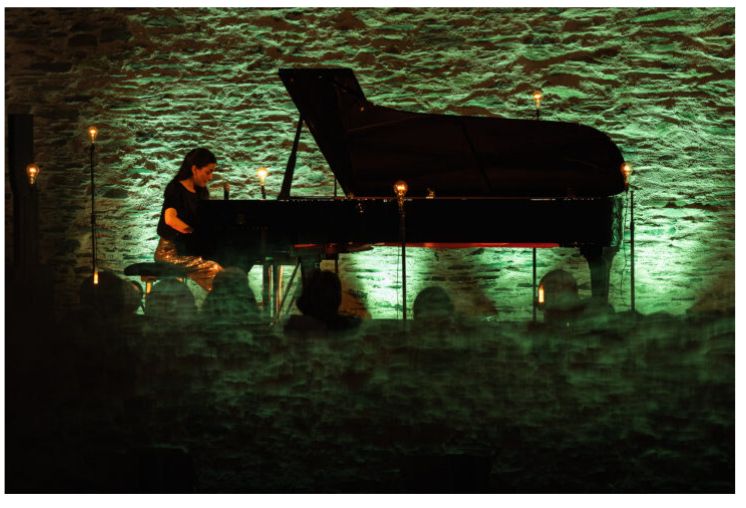
Album of the Month
“Consolations” is selected as Album of the Month by International Piano
“Her playing is glourously free and unhibited, her vocal line sung with heart-rending emotional warmth“
“In sum, Liszt playing of this order or poetic richness and immediacy is rare indeed and Giorgini’s recording should be in possession of those who call Liszt’s stature into doubt“
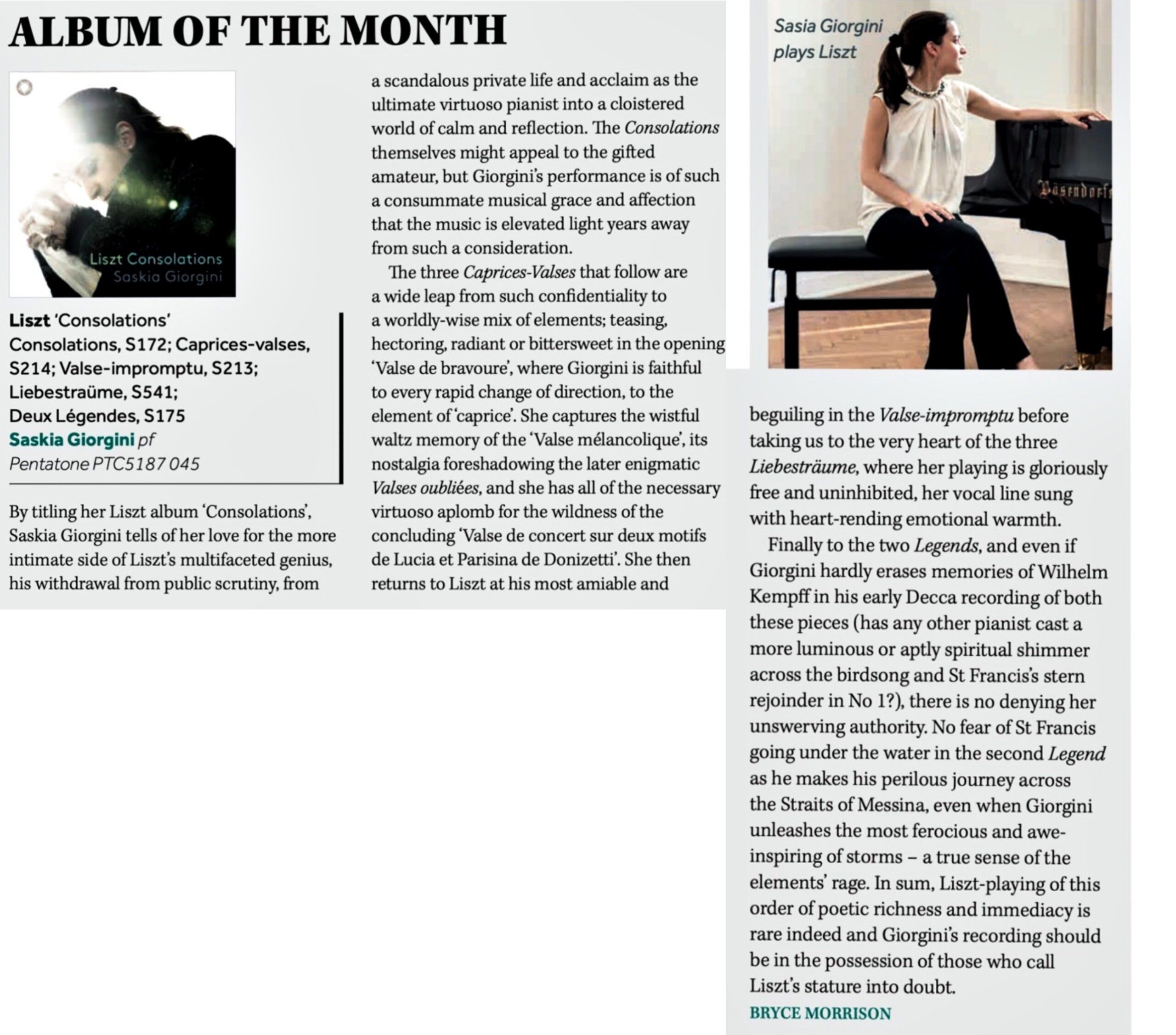
CD Review (Liszt – Harmonies Poétiques et Religieuses)
Machiel Swillens, Luister
What a marvellous CD! Giorgini makes her Bösendorfer pray, cry and sing. With an incredible feeling for structure she stretches big arches from one piece to the other, she understands the art of making the sounds become liquid and let the magic float weightlessly around the room. (…)
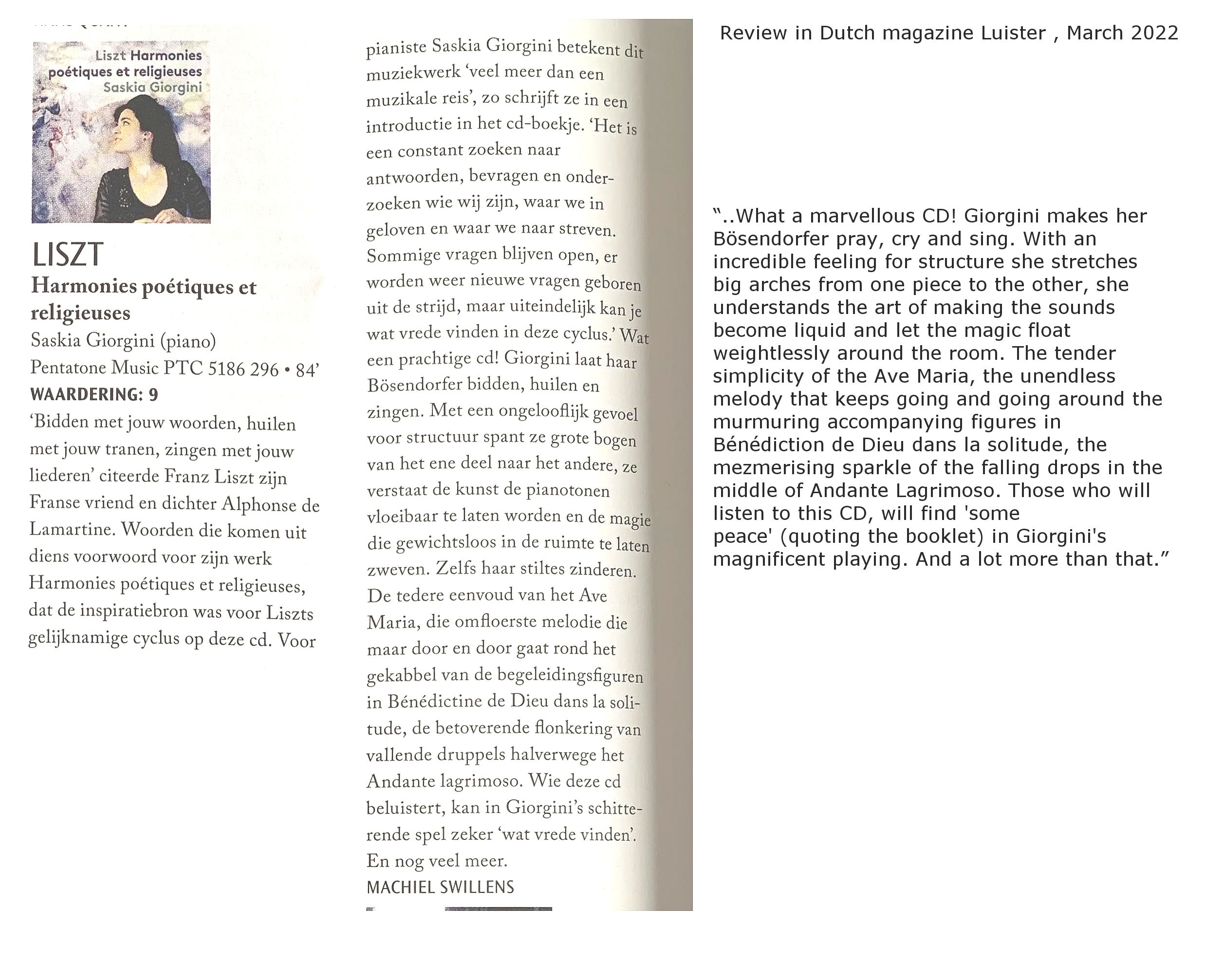
Diapason D’or (Liszt – Harmonies Poétiques et Religieuses)
Diapason
On a splendid Bösendorfer, Saskia Giorgini delivers a realization of Harmonies Poétiques et Religieuses in which her constantly inspired playing is carried by an emotional fervour.
The rich sound of the Dutch-Italian pianist, winner of the Salzburg Mozart Competition in 2016, contributes to the understanding of this unfairly neglected opus.
The suave Ave Maria and the lamenting Andante Lagrimoso strike here with their magnificent interiority, whose climate makes one think irresistibly of Fauré.
The Hymne de l’enfant à son reveil sings with a penetrating sweetness, the Pensée des morts, more prophetic and hallucinated than ever, takes us to a frightening dimension. Funérailles never crush us under their weight but sing with infinite poetry, the Cantique d’amour sounds ideally glorious. The spiritual peak is reached with Bénédiction de Dieu dans la solitude. How Saskia Giorgini plays it with truly divine intimacy! A simple and sensitive vision of this essential masterpiece of the Lisztian piano was missing. We have it today.
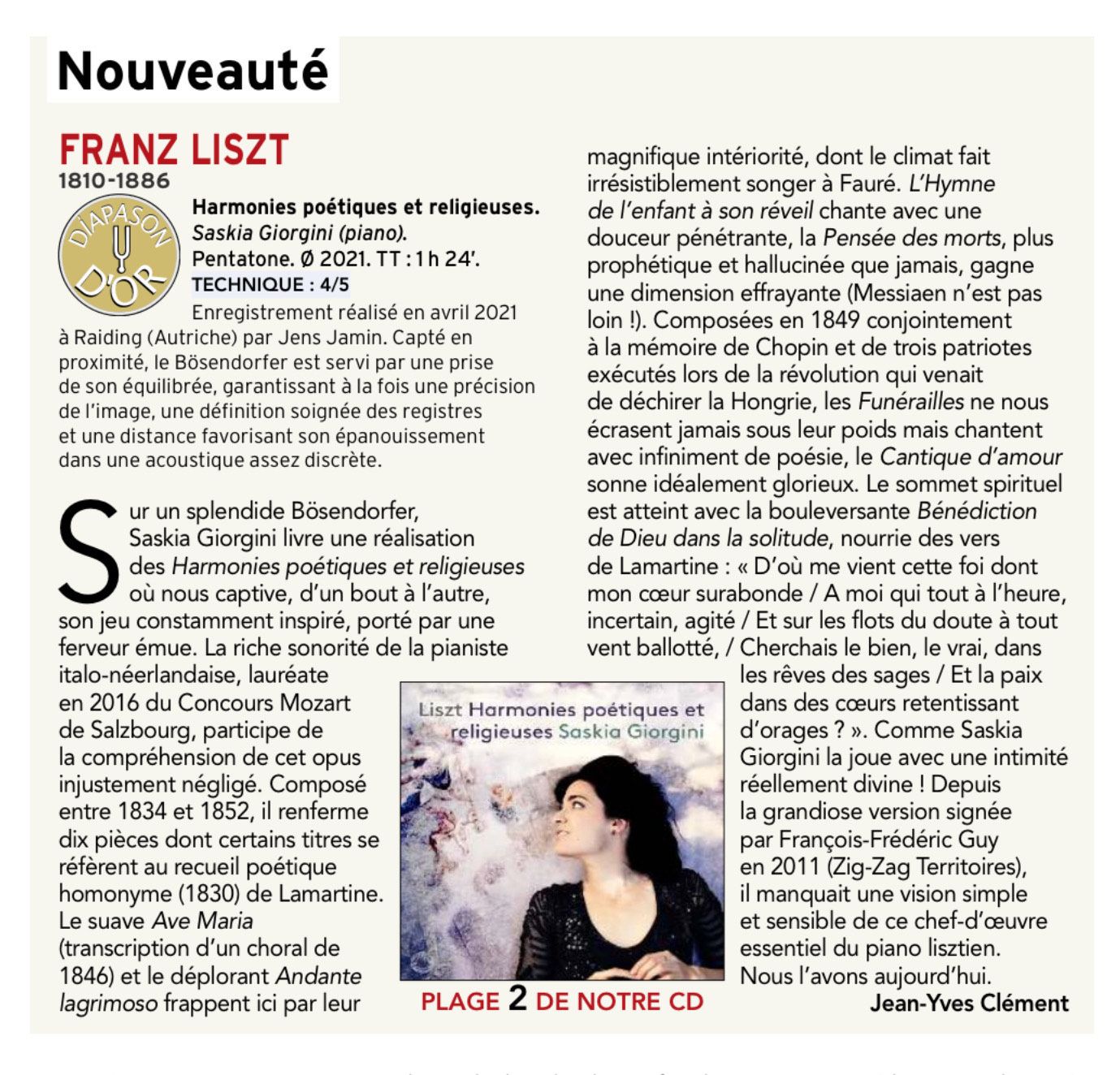
CD review ***** (Liszt – Harmonies Poétiques et Religieuses)
Franck Mallet, Musikzen.fr
“Saskia Giorgini en totale osmose avec l’esprit Lamartinien de la partition”
“Superbe”
CD review ***** (Liszt – Harmonies Poétiques et Religieuses)
Aart van der Wal, Opus Klassiek
As a matter of fact, her Liszt is simply stunning. Unfortunately, this beautiful music does not always sound this radiant, this expressive and so richly varied. Giorgini’s lyrical signature is just as impressive (perhaps overwhelming is a better word) as the technical allure of her playing. Exuberance and stillness, virtuoso rhetoric and deeply felt contemplation: Giorgini apparently does not hesitate in this enchanting and catchy recital in which magic is highly regarded. And these are truly colossal pieces, both in terms of pianistics and content, with the absolute ‘outliers’ being III Bénédiction de Dieu dans la solitude, IV Pensée des morts and VII Funérailles. The Bösendorfer 280VC (why do we hear so little of the instruments of this famous piano builder?) is beautifully captured. No less than 85 minutes of pure beauty on one CD. Unbelievable.
Interview about Enescu’s music (in Romanian)
Review (Enescu Festival, Bucharest)
Dana Cristescu, Hotnews.ro
The moment of maximum delight, not a shock, is still the winner of the Mozart Competition, Salzburg, 2016, with the interpretation of Fantasy for piano and orchestra by George Enescu, given to us by Saskia Giorgini. An exceptional pianist.
Review (Enescu Festival, Bucharest)
Lavinia Coman
(…) pianist Saskia Giorgini competed on the solo part, integrating harmoniously into the fabric of the symphonic ensemble. To the roars of prolonged applause, the artist responded with an emotional supplement, the lied by Rachmaninov In the Silence of the Mysterious Night, in the inspired transcription of the soloist.
Kurier Review
“Italienischer Flair” – Helmut Christian Mayer
“Es zählt zur erfreulichen Programmatik des Lisztfestivals, neben arrivierten Pianisten auch immer jüngere Talente nach Raiding einzuladen. Und so gab es auch diesmal wieder eine beeindruckende Begegnung mit einer Debütantin: die junge Italienerin Saskia Giorgini, Gewinnerin zahlreicher Preise und international bereits durchgestartet, musizierte ein auf ihr Herkunftsland fokussiertes Programm von Franz Liszt.
Aufsteigerin
Da erklangen neben den “Sonetti del Petrarca” und der “Rigoletto-Paraphrase” und dem Finale aus “Aida” auch “Venezia e Napoli” aus den “Années de Pèlerinage” sowie die populäre Symphonische Dichtung “Les Préludes” in der Version für Soloklavier. Giorgini faszinierte dabei den gesamten Abend mit kraftvollen, sicheren Anschlägen und perlenden Läufen, aber auch feiner Sensibilität, meisterte alle diffizilen Vertracktheiten mit höchster Virtuosität souverän und wurde vom Publikum zu Recht bejubelt”
Die Burgenländerin Interview
“Klavierladies” – Viktoria Kery-Erdély
www.dieburgenlaenderin.at/people/190510_klavierladies-171910/
The Observer Review (the Guardian)
Fiona Maddocks
(…) Then, in New Cumnock’s stunning town hall, Saskia Giorgini, the Italian pianist and Salzburg Mozart competition winner, made her (barefoot) Scottisch debut in a thrilling, flawless recital of Haydn, Schubert, Enescu and Liszt.
La Stampa Article
Franca Cassine
Funambola sui tasti. La brava pianista si riconosce dal gesto
La Stampa Review
Giorgio Pestelli
Giorgini fa vivere i “Sonetti” di Liszt
“Liszt’s Petrarca Sonnets are difficult to bring to life because of their introverted quality, not only a pianist is needed, but a musician, like Saskia Giorgini, who at the Unione Musicale last night made them explicit and brought them to life wonderfully”
Bonner Rundschau Review
Jürgen Bieler
Mit Würde, Ausdruck und Kunstfertigkeit
Klassische Philharmonie Bonn – Pianistin Saskia um Zugaben gebeten
„[…Mozart Piano Concerto K453] Attention, perfect timing for the flowing switches between piano and winds, together with coloured playing and fluent finger dexterity, Saskia Giorgini solved the technical and interpretation demands really outstandingly, from the inspired cadenzas to the incredibly precise but graciously dancing arabesques around the winds. This was a top-class Mozart, one can easily understand why she won the first prize in Salzburg. She could only first come off stage after 2 encores.”
Schwaebische Review
Christel Voith
Konzert zeigt Todesahnung mit Schwung. Intoxicating Sunday matinée with pianist Saskia Giorgini
Saskia Giorgini played a varied program in a thrilling piano recital.
The beautiful and charming winner of the 2016 Mozart Competition in Salzburg came on stage with a refined backless glitzing shirt and black trousers, but more impressive was her mature, cultivated playing.
It was fascinating watching her graceful hands play the powerful passages in Beethoven sonata op.53. An imaginative playing, with poetic restful moments, a happy sputtering but persistent flow in a lively dialogue between both hands. The Adagio was started quietly and introverted, slowly a melody was born, creating a marvellous entrancement, until the light came out again in the last movement.
The concert started with Mozart’s Fantasy KV 475. With the deepest calm, after sitting down, the pianist deeply sank in a world of grief and death premonitions, where sometimes, with soft passages, a light hint of hope would shine through. Completely different were the dazzling 6 Preludes (1967) by W. Rihm that stretch from virtuosic studies to octaves and feverish chords sequences, a waltz caricature and an alienated cantilene. With exciting lightness and liveliness Saskia Giorgini finished with Mikhail Pletnevs piano suite from Tchaikovskys ballet “Sleeping Beauty”. A liberating and virtuoso music making from the Dance of the Pages until the effervescent finale.
Suedkurier Review
Corinna Raupach
Saskia Giorgini spielt mit großem Ausdruck. Die italienische Pianistin begeistert im Kiesel mit brillanter Technik und freundlichem Ton
“Dunkel steigen erste Töne vom Flügel auf, von weit her antworten verhaltene Seufzer. Noch tiefer klagt der Flügel, noch schmerzlicher seufzt er – bei aller Ruhe liegt eine fast greifbare Spannung über dem Spiel von Saskia Giorgini im Kiesel. Sie löst sich etwas, als die Melodie zu fließen beginnt, erst in der rechten, dann in der linken Hand. Ruhelos pulsieren Sechzehntel-Noten, ehe die Musik in einem lyrischen Thema ganz zu sich findet. (…)”
Liszt Blog Review
Alexander Buskermolen
“With the Müller Lieder Giorgini made a wonderful statement: it was played with a deep emotional understanding for the music, choosing tempi, colors, dynamics accordingly to the movement at hand. Everything was played a 100% clean and accurate. In particular the use of rests, pianissimo and general timing made for a stunning performance. And we sat in silence and just listened how the recital progressed.
The March hongroise was played with great articulation, stability in tempo and full of character [..]
Keeping the tension beautifully, Saskia Giorgini continued her performance, [..] in Die Zelle in Nonnenwerth Giorgini instantly changed her palet of colors, choosing for a dreamy kind of approach. This dreamlike quality of sound didn’t mean the clarity was gone, on the contrary! In the upper part of the register, she made sure the Fazioli 2,87 was working in her advantage. It sang beautifully. The use of the inner cantabile voicing was again wonderful, and progressed into a very well structured climax. The exact same could be said about Les Préludes, again making it obvious that she is made for this music.”
